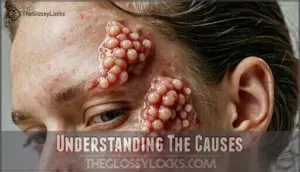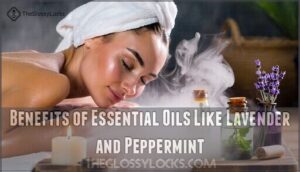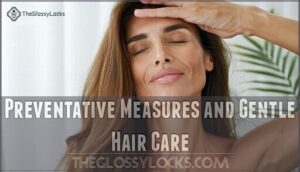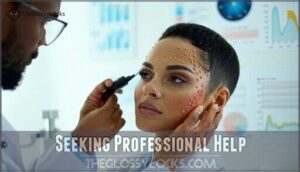This site is supported by our readers. We may earn a commission, at no cost to you, if you purchase through links.
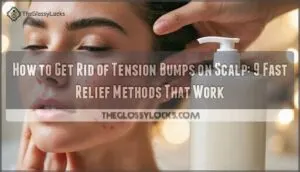
To ease them, start by loosening your hair—those tight ponytails and braids might be the culprits. Try massaging your scalp gently with lightweight oils like tea tree or peppermint, which can reduce inflammation and boost circulation.
Wash your hair with soothing, sulfate-free shampoo to calm the area further. Avoid heavy styling products, and give your scalp some breathing room.
If the bumps persist, consider consulting a dermatologist to rule out infections or other issues. A healthier scalp might just be a hairstyle away.
Table Of Contents
- Key Takeaways
- Identifying Tension Bumps on The Scalp
- Natural Remedies for Soothing The Scalp
- Preventative Measures and Gentle Hair Care
- Scalp Massage and Improved Circulation
- Seeking Professional Help
- Frequently Asked Questions (FAQs)
- How do I get rid of tight bumps on my scalp?
- How do I get rid of tension in my scalp?
- Why do I get bumps on my scalp from a tight ponytail?
- Are there specific hairstyles ideal for sensitive scalps?
- What fabrics for hats or scarves are scalp-friendly?
- How does stress impact the occurrence of tension bumps?
- Conclusion
Key Takeaways
- Loosen tight hairstyles and switch to looser styles to ease pressure on your scalp and prevent bumps.
- Use lightweight oils like peppermint or tea tree to soothe inflammation and reduce irritation.
- Massage your scalp regularly to improve circulation and promote healing of irritated follicles.
- Consult a dermatologist or trichologist if bumps persist for more than two weeks or show signs of infection.
Identifying Tension Bumps on The Scalp
You’ll recognize tension bumps as small, red, and often itchy raised spots along your hairline or near tight hairstyles.
These uncomfortable bumps typically appear when hair follicles become inflamed from tight braids, ponytails, or buns that pull on your scalp, causing tension.
Recognizing The Signs and Symptoms
Struggling with mysterious bumps on your scalp?
Tension bumps typically appear as small, red raised areas along your hairline or where hairstyles pull tightly.
You’ll notice itching that ranges from mild to severe, often accompanied by stinging or burning sensations.
Pain assessment is vital—if touching the area hurts badly, infection may be present.
Watch for symptom progression; yellowing or drainage indicates worsening conditions requiring immediate attention.
These sensations may be related to underlying scalp issues, which can cause severe discomfort and mild itching, and may lead to infection if not treated properly.
Understanding The Causes
Nearly all scalp tension bumps stem from excessive pressure on hair follicles.
Tight hairstyles like braids, buns, or ponytails are the main culprits, creating ideal conditions for scalp folliculitis and bacterial infections through product buildup, friction, and sweat.
Tight hairstyles can trigger scalp folliculitis, inviting irritation, bacterial infections, and discomfort from sweat, friction, and product buildup.
Your hairline and temples are especially vulnerable due to their delicate skin, making them prone to these painful bumps.
Even seemingly harmless habits like frequent hat-wearing can trigger these painful bumps through constant scalp pressure, highlighting the importance of avoiding excessive pressure on the scalp to prevent bacterial infections.
Natural Remedies for Soothing The Scalp
You can ease those painful tension bumps with natural ingredients that won’t harm your scalp or hair.
Nature provides powerful remedies like essential oils and plant extracts that reduce inflammation and promote healing without harsh chemicals, using natural ingredients.
Benefits of Essential Oils Like Lavender and Peppermint
When your scalp feels under siege from tension bumps, essential oils like lavender and peppermint can provide effective relief through their natural healing properties.
Lavender’s calming effects work to:
- Reduce scalp inflammation with its anti-inflammatory compounds
- Prevent infections thanks to natural antimicrobial properties
- Promote healing of irritated follicles while reducing stress
Peppermint’s cooling sensation immediately soothes irritated areas while stimulating blood flow to deliver nutrients directly to hair follicles. Peppermint oil can also help with stimulating hair follicles for potentially thicker hair.
For best results, create DIY scalp treatments by mixing these oils with carrier oil choices like jojoba or coconut oil (ratio: 3-5 drops essential oil per tablespoon of carrier oil). Apply your oil blend recipe directly to trouble spots, massaging gently to improve absorption. These natural remedies can substantially reduce discomfort while supporting long-term scalp health.
The Role of Castor Oil in Scalp Health
While lavender and peppermint oils work wonders for scalp health, castor oil deserves special attention for treating tension bumps.
This thick, nutrient-rich oil contains ricinoleic acid, which delivers powerful anti-inflammatory properties that calm scalp inflammation and reduce irritation.
When applied to affected areas, castor oil creates a protective barrier that locks in moisture, improving scalp hydration substantially.
What makes castor oil unique is its balanced oil absorption rate – it penetrates deeply without leaving residue.
For best results, warm a small amount between your palms and gently massage it into your scalp before bed.
The oil works overnight, breaking down buildup around hair follicles while supporting hair growth.
Regular application twice weekly can dramatically decrease scalp bumps and improve overall scalp health.
You can also improve your hair’s condition with a castor oil hair mask.
Preventative Measures and Gentle Hair Care
You can prevent painful tension bumps by choosing looser hairstyles and taking regular breaks between protective styles.
Your scalp needs time to recover, so opt for lightweight extensions and communicate with your stylist about your comfort level when getting braids or updos.
Adjusting Hairstyles to Reduce Tension
Your hairstyle choices directly impact scalp health and tension bump development. Adjusting how you wear your hair can prevent painful scalp irritation.
Here are 5 ways to reduce hair tension:
- Rotate between looser styles and tight ones, giving your scalp regular breaks from strain
- Change your part line weekly to distribute weight and pressure evenly across your scalp
- Allow at least one "free hair day" between protective styles to let follicles recover
- Loosen hair braid tension by requesting your stylist use gentler techniques
- Monitor how your scalp feels—if it burns or stings during styling, it’s too tight
These adjustments prevent tension bumps while still enjoying versatile styling options. They are essential for maintaining a healthy scalp and preventing painful scalp irritation. By following these tips, you can reduce hair tension and keep your scalp healthy.
Choosing The Right Hair Extensions
While adjusting your hairstyle helps, the extensions you choose matter just as much.
Opt for lightweight extensions that match your hair’s texture to minimize scalp stress.
Clip-ins and tape-ins cause less tension than tight braids or sew-ins.
Always discuss weight considerations with your hair stylist before installation.
For options, consider exploring different extension types.
The right attachment methods prevent those painful braid bumps, especially when color blending and extension materials work harmoniously with your natural hair to achieve a natural look and minimize scalp stress.
Scalp Massage and Improved Circulation
You’ll find relief from tension bumps by gently massaging your scalp to increase blood flow and reduce inflammation.
Regular massage helps loosen tight follicles and allows healing nutrients to reach affected areas more efficiently, which in turn can help with inflammation.
Techniques for Effective Scalp Massages
Now that you’ve eased up on tight styles, it’s time to give your scalp some hands-on relief. Proper scalp massage techniques can dramatically improve scalp circulation and eliminate tension bumps.
Here are 3 effective scalp massage methods:
- Apply gentle massage pressure using circular motions with your fingertips, working from front to back
- Maintain comfortable oil temperature – slightly warm oils penetrate better and enhance scalp blood flow
- Limit session duration to 5-7 minutes, allowing adequate time for increased circulation without irritation
For best results, consider using a quality massage oil to enhance the experience. For best results, use massage tools like silicone scalp brushes when your scalp is particularly sensitive to touch, and remember to apply gentle massage pressure for optimal relief.
The Importance of Using Lightweight Oils
When treating tension bumps, choosing the right oils can make all the difference for your scalp health. Lightweight oils penetrate effectively without clogging pores, which is essential for preventing further irritation.
Consider oil absorption rates when selecting products—jojoba, grapeseed, and argan oils are excellent carrier oil choices because they closely mimic your scalp’s natural sebum. These oils deliver lightweight oil benefits without causing buildup that can worsen hair folliculitis.
For application methods, use your fingertips to massage just 3-5 drops directly onto affected areas. Tea tree oil mixed with a carrier oil works particularly well as a scalp bump natural treatment due to its antimicrobial properties. Regular scalp massage can offer increased blood circulation to the affected areas.
Apply oils to a clean scalp and leave them on for at least 30 minutes before washing. These scalp bump home remedies can provide significant relief when used consistently, reducing inflammation and supporting healing of damaged follicles.
Seeking Professional Help
If you’ve tried home remedies for two weeks without success, it’s time to consult a dermatologist or trichologist who can offer specialized treatments.
Professional medical care provides access to prescription-strength solutions like medicated shampoos and corticosteroids that effectively target persistent tension bumps on your scalp.
When to Consult a Trichologist or Dermatologist
While massage improves circulation, some scalp issues need expert eyes.
When should you seek professional help? Consider consulting a trichologist or dermatologist if you notice persistent symptoms that don’t respond to home remedies after two weeks.
Severe inflammation, hair loss concerns, or signs of systemic infection (like fever or spreading redness) warrant immediate attention. Trichologists specialize in scalp health specifically, making them ideal for chronic conditions.
Dermatologists offer medical expertise for diagnosing underlying skin conditions causing those stubborn bumps. One option is low-level laser therapy for stimulating hair follicles.
Don’t wait too long—untreated scalp issues can worsen. Most insurance plans cover dermatologist consultations, while trichologist visits may require out-of-pocket payment but provide specialized scalp professional guidance.
Treatment Options for Severe Cases
When home remedies fail to solve your tension bumps, professional medical help becomes your next step.
A dermatologist can offer several effective treatments for those stubborn scalp bumps:
- Medicated shampoos combined with prescription treatments can tackle severe scalp acne that won’t respond to over-the-counter options
- Antibiotics (oral or topical) fight bacterial infections causing folliculitis and prevent systemic infections
- Warm compresses applied before treatment help drain pus from inflamed bumps for faster healing
- Prescription-strength antifungal medications treat conditions like scalp ringworm, with treatments lasting up to 6 weeks
- Corticosteroid use reduces inflammation and provides relief from painful, swollen bumps
For persistent cases, your doctor might recommend more advanced options like laser therapy or microdermabrasion benefits. These treatments can be particularly effective when scalp bumps keep returning despite other interventions.
Remember to follow your dermatologist’s scalp bump medical advice closely. Even with prescription medication, you’ll need to maintain good scalp hygiene to prevent recurrence.
Frequently Asked Questions (FAQs)
How do I get rid of tight bumps on my scalp?
Loosen tight hairstyles, gently massage your scalp, and apply warm compresses to reduce inflammation.
Use soothing oils like peppermint or lavender to calm irritation.
Switch to lightweight styles and keep your scalp clean and moisturized.
How do I get rid of tension in my scalp?
Feeling like your scalp’s in a tug-of-war?
Loosen tight hairstyles, gently massage with essential oils like peppermint, and keep your scalp clean.
Add a soothing compress to relax those stressed follicles and ease the tension.
Why do I get bumps on my scalp from a tight ponytail?
Tight ponytails pull on your hair follicles, creating tension that irritates the scalp.
This stress can inflame follicles, leading to red, itchy bumps.
It’s your scalp’s way of signaling that it needs less pressure.
Are there specific hairstyles ideal for sensitive scalps?
Loose hairstyles like low buns, relaxed braids, or leaving hair down work well for sensitive scalps.
They minimize tension, reduce friction, and help your scalp breathe.
Avoid tight styles or heavy extensions to stay comfortable.
What fabrics for hats or scarves are scalp-friendly?
Choose soft, breathable fabrics like cotton, silk, or satin for hats and scarves.
They’re gentle on your scalp, prevent irritation, and allow airflow.
Avoid rough materials like wool or polyester to reduce friction.
How does stress impact the occurrence of tension bumps?
Stress can feel like carrying an invisible backpack, and your scalp pays the price.
It triggers muscle tension, increases oil production, and lowers immunity, creating the perfect storm for irritation and those painful tension bumps.
Conclusion
Are tension bumps on your scalp interrupting your comfort?
Taking simple steps like loosening tight hairstyles, using lightweight oils, and switching to a gentle, sulfate-free shampoo can work wonders.
Regular scalp massages can also improve circulation while easing irritation.
Don’t ignore persistent bumps—consult a dermatologist to verify there’s no underlying condition.
A little extra care can give your scalp relief and restore its health. You’ll soon feel better and more confident tackling your hair challenges.
- https://www.healthline.com/health/essential-oils-for-hair-growth
- https://www.vinmec.com/eng/blog/essential-oils-that-stimulate-hair-growth-en
- https://nikura.com/blogs/discover/peppermint-oil-for-hair
- https://tangieco.com/blog/the-wonders-of-peppermint-essential-oil-in-shampoo-bars/
- https://jill.health/does-rosemary-lavender-or-peppermint-oil-stop-hair-loss/


